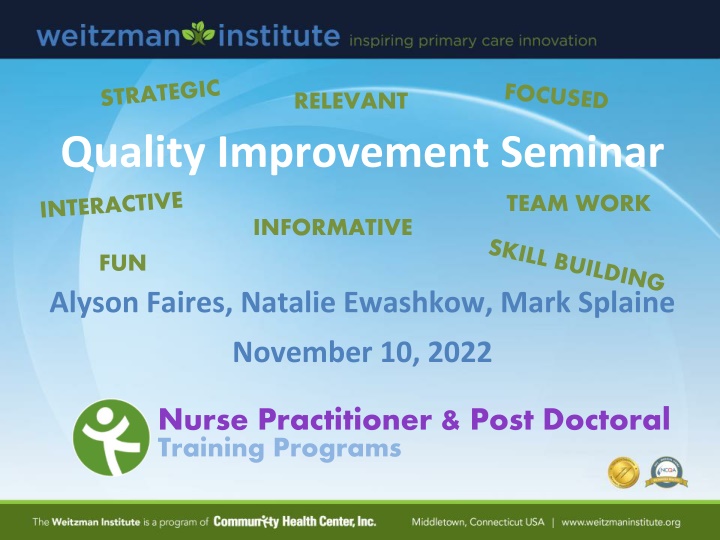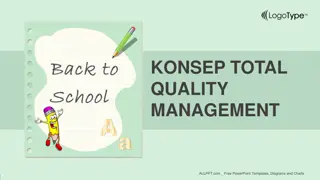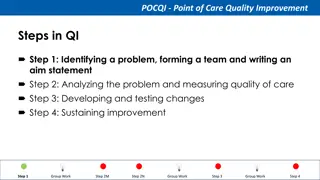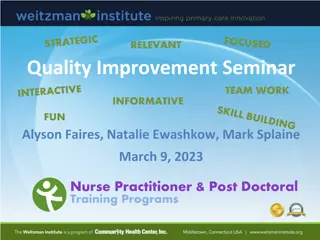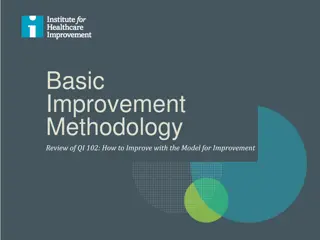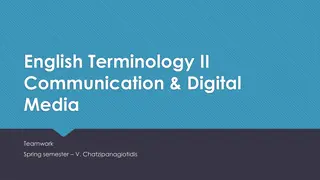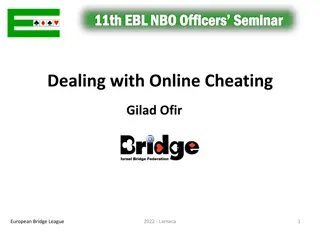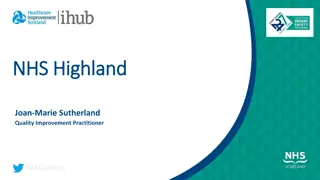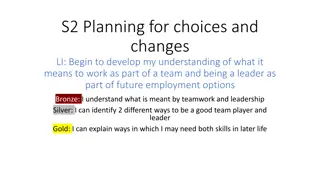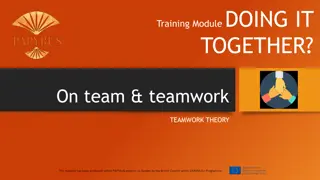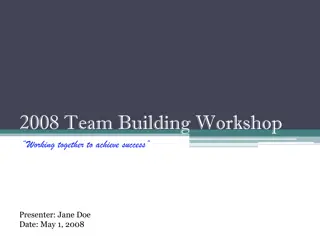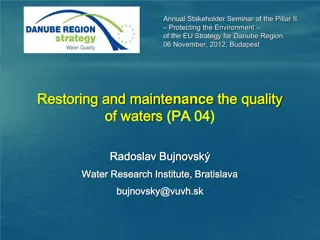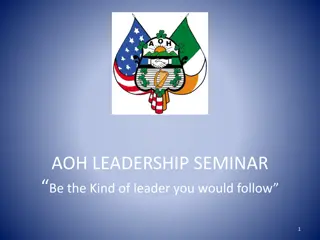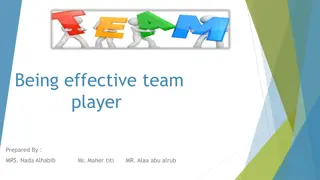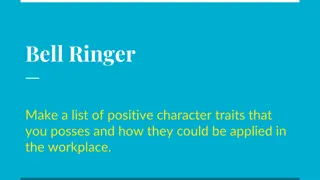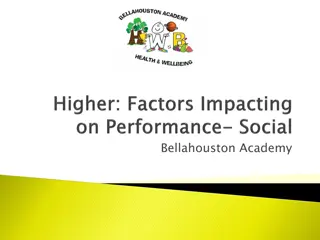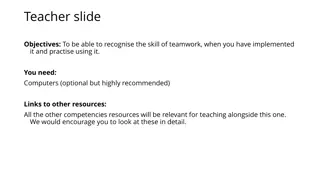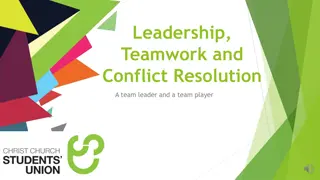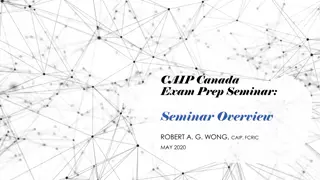Quality Improvement Seminar on Teamwork and Informative Fun
Quality Improvement Seminar focusing on teamwork and informative fun, led by healthcare professionals Alyson Faires, Natalie Ewashkow, and Mark Splaine. The seminar aims to review common health center Quality Improvement infrastructure, draft project charters, consider stakeholders, and introduce new templates. The agenda includes interactive sessions, stakeholder considerations, and a preview of upcoming sessions in the curriculum plan. Participants can expect educational sessions on improving healthcare practices and fostering collaborative teamwork.
Download Presentation

Please find below an Image/Link to download the presentation.
The content on the website is provided AS IS for your information and personal use only. It may not be sold, licensed, or shared on other websites without obtaining consent from the author.If you encounter any issues during the download, it is possible that the publisher has removed the file from their server.
You are allowed to download the files provided on this website for personal or commercial use, subject to the condition that they are used lawfully. All files are the property of their respective owners.
The content on the website is provided AS IS for your information and personal use only. It may not be sold, licensed, or shared on other websites without obtaining consent from the author.
E N D
Presentation Transcript
RELEVANT Quality Improvement Seminar TEAM WORK INFORMATIVE FUN Alyson Faires, Natalie Ewashkow, Mark Splaine November 10, 2022 Nurse Practitioner & Post Doctoral Training Programs
Session Goals Review common health center QI infrastructure Hear about and discuss your efforts to draft a project charter for your project idea Consider which stakeholders may be relevant for your project Introduce two new templates (global aim & fishbone diagram) 2
Roles Theory burst presenter Mark Interactive exercise leader Alyson Timekeeper & facilitator Natalie Technical genius Tempestt Take-home thoughts report-out Nicole 3
Agenda Welcome (5 minutes) Improvement priority examples (5 minutes) Brief review of project charter (10 minutes) Project charter small group work (30 minutes) Break (5 minutes) Stakeholder considerations (10 minutes) Summary and take-home points (5 mins) Introduce new templates (5 minutes) Global aim statement Fishbone diagram Preview of next session (5 minutes) 4
Curriculum Plan An overview of Quality Improvement (10/13/22) Care Observations & Stakeholder Considerations (10/27/22) Organizing your Improvement Project (11/10/22) Global Aim and Fishbone Diagram (12/8/22) Process Mapping (Flowcharts) (12/22/22) Measurement to Inform Change (1/12/23 & 1/26/23) An Approach to Testing a Change (2/9/23) Communication about your Improvement Effort (2/23/23) Stakeholder Analysis & Conflict Management (3/9/23) Managing Up and Gaining Leadership Buy-In (3/23/23) Negotiation (4/13/23) Negotiation and More About Cycles of Change (4/27/23) Sustaining your Improvement Effort (5/11/23) Resident Presentations (5/25/23, 6/8/23, 6/22/23)
Organizational QI Priorities Where do they come from? Input from many levels of organization How often are they set? Annually How are they tracked? Multiple approaches 6
Common QI Infrastructure A Chief Quality Officer (organizational QI leader) leads a committee, organizes recommendations, and compiles a report to the senior leadership and board for approval annually A corporate quality committee consisting of representatives from local sites, organization quality leaders, and service line/senior leaders Board member input and involvement Overall Board of Directors Also, often a subcommittee (e.g., Compliance/Performance Improvement (CPI) committee) Quality teams at the local clinical sites that provide initiatives for their local patient populations. 7
Planning a QI Project Using a Project Charter 8
A PROJECT CHARTER adds structure as you plan What are we trying to accomplish? & Why? Will we know if the change made an impact? A tool for training and/or communication Baseline data Goals Measures Stakeholders Barriers Expectations Ideas 10
Date charter revised Problem Statement Create this statement with team Team Members Include coach, sponsor and each member (core and extended) Central Question/ Why work on this now? Create this statement with team What is the impact anticipated OR what are the current losses Measures Measurement from PI Goals If implementation goal evidence that it is implemented? Goal Statement Goals from PI Goals spreadsheet baseline and follow up. Milestones/ Dates Date team first meeting and date project charter created Deliverables and when they are due Date each PDSA launched, completed. Scope Document first last process steps. List areas of exclusion for this project Problem Statement Create this statement with team Include coach, sponsor and each member (core and extended) Team Members Create this statement with team What is the impact anticipated OR what are the current losses Central Question/ Why work on this Project Charter Template now? Measurement from PI Goals If implementation goal evidence that it is implemented? Measures Goal Statement Goals from PI Goals spreadsheet baseline and follow up. Date team first meeting and date project charter created Deliverables and when they are due Date each PDSA launched, completed. Milestones/ Dates Document first & last process steps. List areas of exclusion for this project Scope
Problem Statement AVS are not distributed to patients equally, leading to patient confusion regarding follow up plans. Current AVS template is lacking important follow up steps. Team Members Stephanie Randall and Han Ding- NP Residents and ECHC QI Team (measurements) and IT team (template) Central Question/ Why work on this now? Patients are missing important steps after visit including completion of lab work, imaging, picking up prescriptions, and follow up appointments Measures Measure patient satisfaction survey regarding after visit instructions Percent of AVS provided to patients QI measures- see if QI measures are increased with more AVS provided Goal Statement Goal is to standardize AVS process and template to increase continuity of care Milestones/ Dates Date team first meeting 10/2021 Date project charter created 1/27/2022 Deliver new AVS template by March 1, 2022 Deliverables due by April 15, 2022 Date each PDSA launched, completed: May 2022 Scope Understand current AVS process and identify patients not receiving AVS Provide AVS to all patients AVS are not distributed to patients equally, leading to patient confusion regarding follow up plans. Current AVS template is lacking important follow up steps. Problem Statement Stephanie Randall and Han Ding- NP Residents and ECHC QI Team (measurements) and IT team (template) Project Charter Example from Previous Cohort Team Members Central Question/ Why work on this Patients are missing important steps after visit including completion of lab work, imaging, picking up prescriptions, and follow up appointments now? Measure patient satisfaction survey regarding after visit instructions Percent of AVS provided to patients QI measures- see if QI measures are increased with more AVS provided Measures Goal is to standardize AVS process and template to increase continuity of care Goal Statement Date team first meeting 10/2021 Date project charter created 1/27/2022 Deliver new AVS template by March 1, 2022 Deliverables due by April 15, 2022 Date each PDSA launched, completed: May 2022 Milestones/ Dates Understand current AVS process and identify patients not receiving AVS Provide AVS to all patients Scope
Problem Statement Lack of consistent process for urgent BH referral (WHOs) that impacts time to care Team Members Planning team (us), data collection (medical providers, BH providers, PSAs, office manager) Central Question/ Why work on this now? Pandemic has exacerbated inconsistencies in process and disrupted communication between providers Increase in need of BH services Measures How many appointments get scheduled in a certain amount of time (% within 48 hours) Standardized interview questions to determine understanding of WHO Referral process between key stakeholders (PSA, Medical Providers, Behavioral Health Providers) Goal Statement Define the process related to urgent WHO so that we can decrease time to completion of WHO appointment Milestones/ Dates First Team Meeting 11/21 Project Charter Template Meeting 2/22 Interviews (PSA, Medical, Behavioral) 2/22 Analysis of WHO process, define workflow 3/22 Review Sharepoint WHO data 4/22 Scope Middletown CHC WHO Referral Process starting January 2022 Starting at medical referral and ending with WHO appointment scheduled Lack of consistent process for urgent BH referral (WHOs) that impacts time to care Problem Statement Project Charter Example from Previous Cohort Planning team (us), data collection (medical providers, BH providers, PSAs, office manager) Team Members Pandemic has exacerbated inconsistencies in process and disrupted communication between providers Increase in need of BH services How many appointments get scheduled in a certain amount of time (% within 48 hours) Standardized interview questions to determine understanding of WHO Referral process between key stakeholders (PSA, Medical Providers, Behavioral Health Providers) Define the process related to urgent WHO so that we can decrease time to completion of WHO appointment Central Question/ Why work on this now? Measures Goal Statement First Team Meeting 11/21 Project Charter Template Meeting 2/22 Interviews (PSA, Medical, Behavioral) 2/22 Analysis of WHO process, define workflow 3/22 Review Sharepoint WHO data 4/22 Middletown CHC WHO Referral Process starting January 2022 Starting at medical referral and ending with WHO appointment scheduled Milestones/ Dates Scope
Project Charter Discussion We will break into team-based groups (15 minutes) Each group will review the project charter template and continue their work on completing the template Be prepared to share your draft project charter with the large group 14
Small Group Discussion We will break into team groups: CHC New Britain Holyoke HC CHC New London CHC Hartford CHC Meriden CHC Middletown HealthLinc CHC Stamford CHC Postdocs CHC Danbury Open Door
Highlights from Small Groups Which team would like to share a brief summary of the charter? Was there anything you found challenging or got stuck on in drafting the charter?
Break! Take five minutes to recharge and refresh. 17
Poll Question How do you feel about using the project charter to inform the development of your project as it moves forward? (select one) a. b. c. Really good; we are on track with a solid plan. Good; making progress, and we still have some issues to consider. So so; we are getting there and would benefit from some assistance. Not so good; we are struggling a bit and could use some guidance. d. 18
Stakeholder Considerations Stakeholders are anyone who may be impacted by your project, or whose assistance/guidance you may need for carrying out your project. Common stakeholders team s have consulted with include: Organization or site leaders Other members of your clinical team Patient/clients Based on your project discussion so far, who are some stakeholders you are thinking you may need to get in touch with?
What havent we figured out yet? Questions or issues that remain unclear? 20
Take-home Thoughts Nicole share 1 or 2 ideas you will take away from our discussion 21
Summary You have learned about a framework to guide your thinking about how to organize improvement work Also, we have reviewed an important tool for quality improvement work the project charter Based on our discussion, it is clear you are already making good initial progress on your projects. Our next step will be setting a clear goal and understanding a problem you are wanting to address in your project work. 22
New Templates Global Aim & Fishbone 23
Writing a Structured Global Aim: 1. The aim is to improve the quality and value of... (name the process) 2. The process starts with... (name start point) and the process ends when (name end point) . 3. By working on this we expect to: a. (Name better, hoped for results) 4. It is important to work on this now because . (list reasons) .
Fishbone (Cause & Effect) Diagram A team works together with a structured approach to brainstorming a list of causes of a problem The head of the fish is the problem: Late for work. The bones are causes grouped by category.
Using the Fishbone Template 1. The Head of the fish = The Problem (or effect): Team must agree on the problem statement in the global aim first! 2. What general categories will you use? Typical ones include: Equipment/supplies Technology Staff Processes/procedure Environment Patients 3. Each bone = Contributing Causes within a category 4. Focus on current state!! No solutions yet! 5. Don t worry about messiness
Session IV Highlights We will hear reports from several groups about their draft global aim statement for their project idea We will work in breakout groups to brainstorm causes for a problem statement using the fishbone diagram template 27
Assignment for Session IV If you are not familiar with the idea of brainstorming, watch the two brief videos for examples of a group brainstorming Session preparation (review the templates): Global aim statement Fishbone (cause-and-effect) diagram Work with your site colleagues to generate a draft of a global aim statement for your project topic Contact Alyson, Natalie, or Mark if you have questions or need assistance Send your draft global aim to Alyson, Natalie, and Mark by Wednesday (12/7/22) at 6pm EST Our next session will be on Thursday, 12/8/22 28
Videos to Review The two video links provided below will give you a brief introduction to how a group does brainstorming https://www.youtube.com/watch?v=9K8W4oo ygUU (overview, roughly 4 minutes) https://vimeo.com/9849184 (example, roughly 2 minutes) 29
Upcoming Office Hours & Teams The next four office hours will be on 11/17, 12/1, 12/15, and 1/5 all from 1:00-1:30pm EST We would like to meet with each project team once during office hours in December or January. Please let us know which session your team will attend (limit of four teams per session). This discussion will be for us to learn a bit more about your project plan and to think together how we can assist you in your work 30
References Splaine ME, Dolansky MA, Estrada CA, and Patrician PA. Practice- Based Learning and Improvement: A Clinical Improvement Action Guide (3rd Edition). Oakbrook Terrace, IL: Joint Commission Resources, 2012. Langley GJ, Moen R, Nolan KM, Nolan, TW, Norman CL, and Provost LP. The Improvement Guide: A Practical Approach to Enhancing Organizational Performance (2nd Edition). San Francisco, CA: Jossey-Bass, 2009. 31
